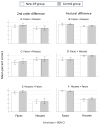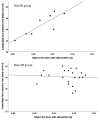Evidence for a Classical Dissociation between Face and Object Recognition in Developmental Prosopagnosia
- PMID: 38275527
- PMCID: PMC10813246
- DOI: 10.3390/brainsci14010107
Evidence for a Classical Dissociation between Face and Object Recognition in Developmental Prosopagnosia
Abstract
It is still a matter of debate whether developmental prosopagnosia is a disorder selective to faces or whether object recognition is also affected. In a previous study, based on a small sample of developmental prosopagnosics (DPs; N = 10), we found impairments in both domains although the difficulties were most pronounced for faces. Importantly, impairments with faces and objects were systematically related. We suggested that that the seemingly disproportional impairment for faces in DP was likely to reflect differences between stimulus categories in visual similarity. Here, we aimed to replicate these findings in a larger, independent sample of DPs (N = 21) using the same experimental paradigms. Contrary to our previous results, we found no disproportional effect of visual similarity on performance with faces or objects in the new DP group when compared to controls (N = 21). The new DP group performed within the control range, and significantly better than the old DP-group, on sensitive and demanding object recognition tasks, and we can demonstrate a classical dissociation between face and object recognition at the group level. These findings are perhaps the strongest evidence yet presented for a face-specific deficit in developmental prosopagnosia.
Keywords: developmental prosopagnosia; dissociation; object recognition; selectivity; visual similarity.
Conflict of interest statement
The authors declare no conflicts of interest. The funders had no role in the design of the study; in the collection, analyses, or interpretation of data; in the writing of the manuscript; or in the decision to publish the results.
Figures






Similar articles
-
Recognition of pareidolic objects in developmental prosopagnosic and neurotypical individuals.Cortex. 2022 Aug;153:21-31. doi: 10.1016/j.cortex.2022.04.011. Epub 2022 Apr 22. Cortex. 2022. PMID: 35576670
-
Recognition of animal faces is impaired in developmental prosopagnosia.Cognition. 2023 Aug;237:105477. doi: 10.1016/j.cognition.2023.105477. Epub 2023 May 6. Cognition. 2023. PMID: 37156079
-
Inversion effects for faces and objects in developmental prosopagnosia: A case series analysis.Neuropsychologia. 2018 May;113:52-60. doi: 10.1016/j.neuropsychologia.2018.03.026. Epub 2018 Mar 26. Neuropsychologia. 2018. PMID: 29596857
-
The cognitive and neural basis of developmental prosopagnosia.Q J Exp Psychol (Hove). 2017 Feb;70(2):316-344. doi: 10.1080/17470218.2016.1165263. Epub 2016 Apr 27. Q J Exp Psychol (Hove). 2017. PMID: 26967836 Review.
-
Electrophysiological studies of face processing in developmental prosopagnosia: neuropsychological and neurodevelopmental perspectives.Cogn Neuropsychol. 2012;29(5-6):503-29. doi: 10.1080/02643294.2012.716757. Epub 2012 Oct 16. Cogn Neuropsychol. 2012. PMID: 23066851 Review.
Cited by
-
Assessment of Developmental Prosopagnosia in an Individual with Tourette Syndrome and Attention Deficit Hyperactivity Disorder: A Case Report.Brain Sci. 2025 Jan 10;15(1):56. doi: 10.3390/brainsci15010056. Brain Sci. 2025. PMID: 39851424 Free PMC article.
References
-
- DeGutis J., Bahierathan K., Barahona K., Lee E., Evans T.C., Shin H.M., Mishra M., Likitlersuang J., Wilmer J.B. What is the prevalence of developmental prosopagnosia? An empirical assessment of different diagnostic cutoffs. Cortex. 2023;161:51–64. doi: 10.1016/j.cortex.2022.12.014. - DOI - PMC - PubMed
Grants and funding
LinkOut - more resources
Full Text Sources

